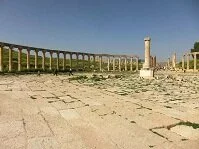
Jerash
Sadly, few architectural changes took place since the Romans left the region. In the 500s and 600s the Muslims arrived and brought in their architecture, and in the 1500s the Ottoman Turks arrived with theirs. Unfortunately, the region always fell on the periphery of their ruling kingdoms and so received almost no architecture other than simple structures, few of which have lasted to the present.
In the 1800s and 1900s the region began to grow and develop, leading to more architecture, but again few pieces of any significance. Today most of the country's buildings were built or renovated in these latter years of the Ottomans and the capital of Amman is in this style, which is much more functional than it is aesthetically pleasing.
Also in the 1900s and into the 2000s, Jordan has received modern buildings, which are much easier to build due to the materials and machines created by the Industrial Revolution, including concrete, steel, and cranes. There are numerous modern buildings in the country, most particularly in the capital city of Amman, although very few skyscrapers exist in the country.